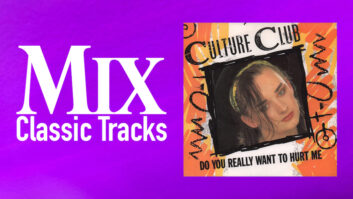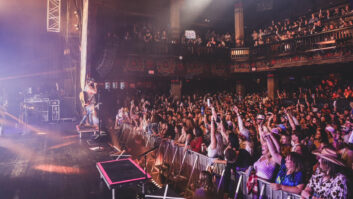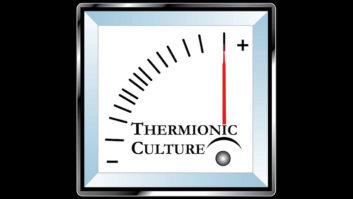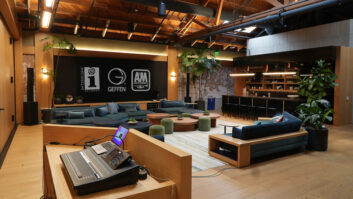In one recent week, I could have seen the following shows within 10 miles of my home:
- A Beatles tribute band who sold out two nights at one of the hottest clubs in town, in the first half-hour after tickets went on sale.
- “Bob Dylan” nights starring the cream of local folk and rock performers, at two different venues.
- A band who plays nothing but the repertoire of John McLaughlin’s early ’70s Mahavishnu Orchestra.
- A folk festival featuring the offspring of Arlo Guthrie, Harry Chapin and Loudon Wainwright.
- A group of sons and brothers of the original Parliament/Funkadelic who call themselves “Funk-Kin.”
- Stage musicals based on songs by Ellie Greenwich (“Leader of the Pack,” etc.) and (God help us) ABBA.
- And a sold-out concert by Robert Plant, who performed not only Led Zeppelin tunes, but also songs by The Youngbloods, Donovan, Moby Grape, Tim Rose and Arthur Lee & Love.
Not long ago, I walked into one of the funkiest little record stores in one of the hippest areas of Boston. You can’t even get through the door of this shop unless you have at least five pieces of metal in your face (I passed because I’m old), and coming out of the speakers, I heard the Blues Project’s 1966 “Flute Thing.”
The latest Arbitron book shows that in my metropolitan broadcast market, three of the Top 10 radio stations are oldies or “classic hits,” stations that differentiate themselves from each other by only the finest of hairs: One won’t play anything recorded after 1972, another won’t play anything post-1979, and the other won’t play anything from before 1966. On a local public station, the most popular new show is called “Highway 61 Revisited,” which features obscure and not-so-obscure folk-rock from the psychedelic era. The announcer barely has time to talk between all the phone requests.
What’s going on here?
That “Flute Thing” I heard wasn’t the Blues Project, it was the Beastie Boys sampling the Blues Project (and according to co-composer Al Kooper, making more money for him than the original ever did). It’s one of thousands of old songs and riffs that are getting new life thanks to sampling, the Internet and Napster, sometimes to the benefit of the original creator, and more often not. The music of today doesn’t just sound like the music of my youth, in an awful lot of cases, it is the music of my youth.
There are many possible explanations for why this is happening. One is, of course, the “baby-boom bulge.” As that big bump on the population charts of people born in the 15 or so years after the end of World War II becomes firmly ensconced in middle age, we are taking our music with us, and — especially as cool new media come on the scene — we’ll keep shelling out for re-issues, new/old material and compilations of the favorite artists of our youth.
A university colleague of mine has a theory about this, which says that people most strongly identify with the music they hear between the ages of 13 and 19, and that identification stays with them forever. So it seems that the market for Jimi Hendrix, the Four Seasons, Three Dog Night and other icons of the ’60s and ’70s won’t die out until we do.
Another explanation is that the ’60s through the early ’80s were the peak years for real “mass” media. After that, broadcasting became so fragmented that there were no longer any points of reference that everyone understood, no songs that everybody knew. A track from Radiohead, Ben Folds Five or REM behind a commercial geared at a large general audience doesn’t have nearly the recognition power — even among those who were born long after the songs came out — of tunes like “Everyday People” (Toyota), “Rocket Man” (AT&T), “Can’t Explain” (Ford), “Our House” (Chase Bank Mortgage), “Brown Sugar” (Pepsi), and perhaps the most recognizable of all great sell-outs, The Beatles’ “Revolution” in that series of Nike ads.
As media outlets have become larger in size and fewer in number, the audience has become ever more Balkanized. Radio stations today are geared toward very specific demographics in terms of gender, age, race and economic status, with each station delivering a particular section of the audience to the corporate mothership. When I was growing up in New York, there were three stations that every kid listened to: the WMCA Good Guys, Bob Ingram and Cousin Brucie on WABC, and Murray the K on 1010-WINS. There were heated arguments in the schoolyard over which station was better, but the music they played was exactly the same. But today, if you listen to only one station, whether it’s urban, new country, hot adult contemporary, alternative rock, or any of the 40 other categories in Arbitron’s ratings book, you will never hear what anyone else is playing.
Television, too, is looking less at drawing huge numbers and more at targeting particular groups: Witness the rise of the WB and UPN networks, which are making plenty of money despite ratings that just a few years ago would have put their programming executives out on the street. I saw an article just today that recalled how All In the Family had four times the audience of CBS’s biggest hit today.
Yet another explanation lies in the fact that the ’60s (which we all know actually lasted from JFK’s assassination to Nixon’s resignation) were — let’s face it — a hard act to follow. A whole lot of new stuff happened then that we’re still imitating and still trying to understand. Do you think obscene lyrics on major label releases are a recent phenomenon? Check out the MC5’s “Kick Out the Jams, Motherfuckers!” on Elektra in 1969. When did angry urban blacks start making records warning white folks to watch out? At least as far back as 1970, when the Last Poets arrived on the scene. Is Marilyn Manson the original, misogynistic, death-obsessed, heavy-metal transvestite? No, that would be Alice Cooper.
Outrageous packaging? How about the cover of “Sticky Fingers” by the Rolling Stones, designed by Andy Warhol and featuring a real pants zipper, or Jefferson Airplane’s “Bark,” which came wrapped in a brown paper bag. Bands who only know three chords? The Ramones. Bands who only know how to make noise? The Stooges. Trance music? Kraftwerk. World music? The Incredible String Band. Bands with degenerate lifestyles? Too many to list.
Bands solely manufactured for television? The Monkees. Boy-toy bands? The Bay City Rollers. Navel-gazing chanteuses? Joni Mitchell and Laura Nyro. Navel-baring pubescent faux virgins simulating orgasms to slick, overproduced, cookie-cutter dance rock? Well, maybe there weren’t any of those.
So, after a decade in which all these things were done for the first time, what do you do for an encore? A lot of the stuff was pretty awful, but a surprising amount of it was really good, and still stands up after all these years, which is hard to say for more recent pop music. I can’t imagine anybody caring much about Limp Bizkit or Blink-182 10 years down the road, any more than they care about Bananarama or Frankie Goes to Hollywood today.
One more thing that’s contributing to the continuing barrage of “classic” hits on the airwaves — especially behind commercials — is the greed factor among aging rockers. Don’t worry, I’m not about to slam Paul McCartney (one of the richest men in Britain) and his mates (also not too badly off) for selling their aforementioned ambivalent political anthem to one of the world’s most notorious employers of sweatshop labor. That honor goes to Michael Jackson, who controls The Beatles’ catalog, and who doesn’t need the money either.
When a reporter asked Bob Dylan about whether he saw anything wrong with licensing perhaps his best-known anti-establishment song to a large financial institution, he laughed and said, “I don’t have any problem with that kind of thing.” Mick Jagger made a big show of objecting to his manager’s selling “Brown Sugar” to Pepsico, but then turned right around and gave “Start Me Up” to Bill Gates for a mere $3 million. (And there’s no truth to the rumor that when Windows 2000 came out, Microsoft tried to get the rights to “19th Nervous Breakdown.”)
Surprisingly few artists have managed to resist the temptation of commercial bucks, among them Bruce Springsteen (who turned down $15 million from Chrysler), Tom Waits and Neil Young, who has been very vocal in his opposition to the practice.
But the most significant reason why yesterday’s music culture is so prevalent today lies in a full-page ad I saw in my local paper not long ago. It announced, “The most incredible music machine since the accordion!” Who was the advertiser? Gateway computers. For a thousand bucks and an Internet connection, you can have all the music you’ve ever wanted, and do anything you want with it.
Technology has simply made it too easy, and too tempting, to steal from the past. And stealing is now, as we all know, an art form. Today’s underground musical heroes are not singer/songwriters, or thrash-metal bands or guitar heroes, they’re remixers, rappers and DJs, who build their fame by taking other people’s creations, slicing and dicing them, ranting and chanting on top of them, or stringing them together. From the first sampled James Brown scream to the wholesale lifting of entire songs, many of today’s “artists” are simply putting together musical jigsaw puzzles, rather than creating anything original. Yes, there is craft in this kind of composition, but it pales when compared to the true act of making music.
Sample-based music is highly dependent on the fact that music from our collective past packs an emotional punch — even just a few seconds of a tune that once meant something to us is enough to trigger a response that instantly recalls the feelings we experienced when we first heard it. So, in many ways, it’s the emotional content of the individual pieces that we’re responding to when we hear a remix, a rap or a DJ’s set, not what the person making the sound at that moment is doing. But what’s even worse is that by ripping these musical moments out of their original context, we remove their original meaning for the next generation of listeners.
The result, it can be argued, is that today we live in a kind of cultural vacuum. Jaron Lanier, the technologist who is credited with inventing the term “virtual reality” and is an accomplished musician, says about the 1990s: “Pop style stopped happening. This is the first period of the century without a distinctive new pop musical style… Artists of all kinds now work in digital tools. They cut and paste from the whole of human creation. In the distant future, when movies are made depicting the ’90s, the only way filmmakers will be able to indicate the period is by putting vintage computers on the set.”
Technological limitations have always had a lot to do with how styles and trends develop, he maintains, and the lack of limitations can be stultifying. “The sound of The Beatles was the sound of what you could do if you pushed a ’60s-era recording studio absolutely as far as it could go. Artists long for limitations; excessive freedom casts us into a vacuum. We are vulnerable to becoming jittery and aimless, like children with nothing to do. That is why narrow simulations of ‘vintage’ music synthesizers are hotter right now than more flexible and powerful machines.”
Now, I’m not saying that new artists have to throw out what they’ve heard over the past 40 years — on the contrary. All new art draws on the past: It gives us points of reference so that we can understand it. The Beatles could not have done what they did without Chuck Berry, Little Richard, Phil Spector and Motown before them. Bruce Springsteen’s music makes reference — sometimes overtly — to Roy Orbison, Woody Guthrie and The Shirelles, to name but three. But Springsteen doesn’t take an old Roy Orbison record and play it from the stage, layering breakbeats and vocals over it. Those records may play over and over in his mind, but it’s how he assimilates, expands and goes beyond his influences to create genuinely new art that makes him brilliant.
Technology has also removed the physicality of playing an instrument, as well as the joys and difficulties of working with a group, from the process of making music. Fingering a guitar, blowing into a flute, plucking a bass, the simple act of singing, these are all things that people who just work with computers and turntables never experience. Those who do more mainstream music, but depend on sample CDs for every beat and lick, are missing these things too. Computers make music too easy: What’s the point of putting a band together of real people, with all their egos, bad habits and varying levels of musicianship, when you can “play” in your bedroom with virtual versions of Steve Vai, Will Lee and Clyde Stubblefield?
So do I have an answer to this? I do: It’s called music education. Music education puts the basic tools for creating musical art into the hands of children, who will be inspired by those tools and make them their own. By itself, a saxophone does nothing: It has to be played. And just that simple act of blowing into a tube and making a sound, and then another and another, and continuously expanding the vocabulary and quality of sounds that can be made, transforms a kid in a way that downloading the latest Britney Spears can never approach.
Sadly, the state of music education in schools over the past couple of decades has become pretty miserable. Years of budget abuse in the name of tax-cutting, standardized testing, “back-to-basics” and other frauds have resulted in many school systems cutting back music programs, if not axing them completely. At the same time, there has been a tremendous emphasis on technology, giving students the message that computers can do everything. So, naturally, kids are drawn to computer-based music manipulation tools that make it easy, but they depend on other people’s creativity for source material.
However, school bands, choruses and orchestras are by far the best way to teach children about music history and repertoire that they’ll never hear on the radio, or even on Napster. And the feeling of participation in a joint creative effort that is dependent on hands, feet, lips, fingers and tongues will internalize the music in a way that just listening to it can’t.
Parents have a role in this too. If you play an instrument, even if you haven’t pulled it out in a while, then dust it off and share what you can do with it with your children. Teach them how to play an instrument, the same as yours or another, and then play together. Sing with them: teach them how to harmonize with you, and with each other.
Children who experience first-hand the joy of making music through physical expression, without a computer as an intermediary, will learn how to develop their own ways of creating meaningful music. Ultimately, they’ll have far less need for someone else to dictate to them what’s good, and they’ll have no need at all to steal. They will have the tools to become the real musicians — the innovators, not the imitators — of the next generation.
Paul D. Lehrman is Web editor for Mix Online and related publications, and he teaches at Tufts University. This month, he celebrates his sixth anniversary as the “Insider Audio” columnist. Check out his earlier columns onwww.paul-lehrman.com.





